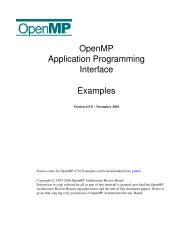D2 3 Computing e-Infrastructure cost calculations and business _models_vam1-final
D2 3 Computing e-Infrastructure cost calculations and business _models_vam1-final
D2 3 Computing e-Infrastructure cost calculations and business _models_vam1-final
Create successful ePaper yourself
Turn your PDF publications into a flip-book with our unique Google optimized e-Paper software.
e-‐FISCAL: www.efiscal.eu <br />
EC Contract Number: 283449 <br />
The TCO model has been used in literature (Nazir <strong>and</strong> Sorensen (2010), Walker (2009)) as a basis for calculating <br />
the <strong>cost</strong>s of e-‐<strong>Infrastructure</strong>s. TCO paradigm is a useful tool when the <strong>cost</strong> of a specific project is to be assessed <br />
over its useful life. The developers of such <strong>models</strong> adopt a forward looking stance covering all expected <strong>cost</strong>s over <br />
the project’s lifetime. This <strong>cost</strong> is divided by the anticipated useful life to come up with a yearly <strong>cost</strong>. However, in <br />
order for this analysis to be precise enough, several details have to be taken into consideration as basis of the <br />
future <strong>cost</strong> estimates. Such details are very difficult to gather consistently across several organisations. PRACE <br />
intends to follow a TCO <strong>cost</strong>ing methodology in order to assess the <strong>cost</strong> of contributing infrastructure 20 . A <br />
graphical representation of TCO is found in Figure 1. <br />
On the other h<strong>and</strong>, Full Cost Accounting methodology is a typical <strong>cost</strong>ing methodology pertaining to all industries <br />
<strong>and</strong> sectors. It relies on actual <strong>cost</strong> accounting data information available within the <strong>cost</strong> accounting systems of <br />
organisations, i.e. it adopts a backward looking stance. Detailed actual data (in line item format) is attributed <strong>and</strong> <br />
allocated on the basis of specific algorithms <strong>and</strong> various <strong>cost</strong>ing procedures to services/products in order to come <br />
up with the “<strong>cost</strong> per unit” of the object being analysed. However, the reliability of the <strong>cost</strong> data depends heavily <br />
on the robustness of the <strong>cost</strong> accounting system. But even in the case of highly developed accounting systems, <br />
<strong>cost</strong>s that are not funded by the organisation are not registered as parts of the total <strong>cost</strong>s. FCA relies on actual <br />
<strong>cost</strong> accounting information (historical) available within the <strong>cost</strong> accounting systems of companies. Moreover, <br />
<strong>cost</strong>s registered in accounting books are influenced by tax considerations (e.g. obsolete infrastructure not used <br />
any more would keep on being depreciated). Nevertheless, FCA is a very useful tool for organizations to control <br />
<strong>cost</strong>s <strong>and</strong> assess performance. Information streaming from FCA can also assist pricing decisions. A graphical <br />
representation of FCA is found in Figure 2. <br />
Salaries <br />
Depreciaqon <br />
Electricity Cost <br />
…… <br />
Asribuqon <br />
or allocaqon through <br />
allocaqon keys <br />
(e.g. m2, FTEs) <br />
Calculaqon of Services’ <br />
<strong>cost</strong> <br />
General <br />
Ledger <br />
Department <br />
1 <br />
Department <br />
2 <br />
Service A <br />
Service B <br />
Service C <br />
Figure 2: Graphical representation of FCA <br />
20 This exercise had not been completed by the end of January 2013. The <strong>cost</strong> categories intended to be included are <br />
presented in section 3. <br />
e-‐FISCAL : Financial Study for Sustainable <strong>Computing</strong> e-‐<strong>Infrastructure</strong>s <br />
Deliverable <strong>D2</strong>.3 – <strong>Computing</strong> e-‐<strong>Infrastructure</strong>s <strong>cost</strong> estimation <strong>and</strong> analysis – Pricing <strong>and</strong> <br />
Business <strong>models</strong> <br />
23




